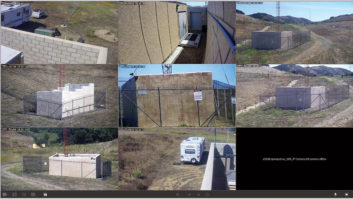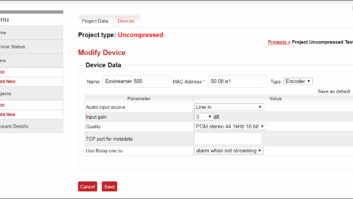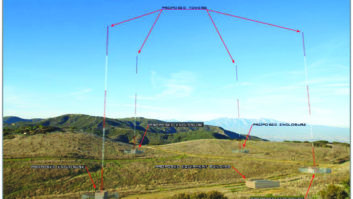Live remote video surveillance
Apr 1, 2009 12:00 PM, By Bryce Witcher

Remote cameras can be monitored by a service 24/7.
“Is it safe?” Do you recall this memorable line in the 1976 classic conspiracy thriller, Marathon Man, with Dustin Hoffman? Is it safe? Is your radio station safe?
According to the Media Security and Reliability Council, radio broadcasting stations �should have appropriate physical security, augmented by security personnel and/or video surveillance at their key facilities, including studios/newsrooms, satellite transmit and receive sites and antenna/transmitter sites.� This is a best-practices measure they are promoting so broadcasters and other mass communication entities protect themselves and their listeners from vulnerabilities in the event of natural and man-made disasters.
But how is a small, remote radio station supposed to afford additional security measures when they can’t afford to take on the extra expenses or hassle? There are many factors in evaluating the need for added or updated security, a variety of preventative measures that can be taken to prevent unwanted acts. One of them includes using video surveillance to achieve detection and early response in the event of an intrusion.
Enforcement tools
Law enforcement representatives indicate that surveillance cameras can act as powerful enforcement tools and crime deterrents. The reality for personnel or security staff at a radio station is that they cannot be everywhere at once. By using video surveillance, the staff can be empowered with an extra pair of eyes to both prevent crime and catch criminals in the act.

Surveillance cameras themselves must be in secured locations.
Many businesses choose video surveillance as part of their overall security approach because of the nearly conclusive evidence it can create, especially when it comes to prosecuting in court. And they are striving to get the most out of their investment. After all, these are tough times, and you have to maximize your investment.
Some station managers may feel that video surveillance is a luxury, but many will agree that employing it is a necessity. Some facilities do not have much in the way of security other than locks on chains on the fencing that surrounds their transmitting towers. Adding a camera can go a long way toward keeping this type of area secure.
Live remote video surveillance
Apr 1, 2009 12:00 PM, By Bryce Witcher

Trained personnel can watch a site for signs of trouble.
Reports indicated that nearly a dozen radio station facilities in Texas were broken into in October 2004. Power supply lines were interrupted and log books were stolen or rifled through. Other fairly minor theft and vandalism occurred, but no expensive equipment was taken, though it could have happened. Law enforcement officials believed in this case that this simply was not ordinary mischief, but a terrorist test to establish police response times and determine how extensive efforts would be to infiltrate the stations to cause a possible interruption of emergency broadcast communications. Had there been some sort of perimeter intrusion detection or video surveillance in place, the perpetrators could have been apprehended.
In creating the most ideal physical security scenario for your station, you don’t always have to start from scratch. Many broadcast facilities already have an existing IP infrastructure that can be exploited by plugging in network cameras. However, installing all the appropriate equipment does not necessarily get you to your goal. You can have all the cameras in the world, but the system needs to be managed and watched on a regular basis.
Most stations are short on staffing, so watching the cameras could become the added responsibility of existing personnel. On the other hand, there are companies that offer monitoring services � for a significantly lower cost compared to hiring your own staff or security guard. The decision to take advantage of that expertise will depend on how you want to allocate resources. If you are fortunate enough to operate a radio station that has security guards, outsourcing the monitoring function can actually save a lot of money because it allows you to reduce or even eliminate your on-site security guard staff. So instead of adding costs, you can minimize them when stepping up your security. Besides, staffing guards who are actually willing to show up to work odd hours can be a headache.
Video storage options
As you’re considering installing a video surveillance system, you will be faced with many video storage options. There are on-site recording devices, such as a DVR, but a technology becoming more widely accepted is video hosting and off-site recording.
Use of this method of recording video is especially promising if an IP network has already been built, and offers several advantages. Because the video is hosted online, the recordings are safely stored off site. You do not need to worry about someone stealing or destroying the on-site recording device while he commits his crime. The video is always accessible through a Web interface, which is especially useful if the staff wants to keep an eye on the transmitter site from the studio. Because the video is online, access can be granted to first responders such as the police so they can assess what kind of response team to dispatch.
Because constantly monitoring the surveillance video is important and knowing that station staff is limited, we can take this one step further. Real-time remote surveillance, or a remote monitoring service, allows trained personnel with the appropriate monitoring equipment to view the surveillance camera system at your studio or tower from their off-site location. This is a security option a growing number of businesses are using, and becoming increasingly popular for anyone interested in mitigating their losses at their broadcasting facility. If you have real-time surveillance services as part of your security program, you have a person working on your behalf to intervene while the incidents are taking place.
Alex Arredondo, an officer at the Los Angeles Police Department (LAPD), was recently involved in an arrest made possible by the services of Iveda Solutions. The California facility is remotely monitored by the company’s staff via the Internet from its surveillance center in Arizona. When the intervention specialist on duty alerted the LAPD that a break-in and theft was taking place, Arredondo and his fellow officers were able to apprehend the perpetrator.
Whether or not you use video surveillance at your station will largely depend on how secure you need the facility to be, compared to what you are willing to invest. The benefits of using video surveillance can speak for themselves in terms of reducing the chance of experiencing lost air time. Reductions in the occurrences of theft and vandalism are also an advantage. The only drawback of implementing video security can be the initial investment on cameras. But, you will be surprised of the savings when you compare the cost of traditional guard services, even when you have to buy equipment in the first year. Needless to say, savings in subsequent years is astronomical. The pros definitely outweigh the cons; therefore it is time to consider using video surveillance for your facilities.
Witcher is the marketing manager for Iveda Solutions, Mesa, AZ.








